NISSAN
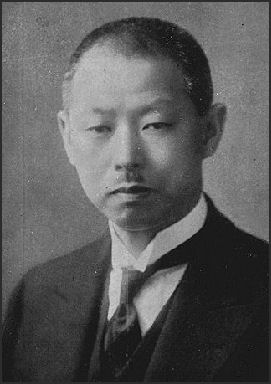
Nissan founder Nissan was Japan’s No. 2 automaker in 2010-2011 in terms of sales volume. Honda and Nissan fight it out to be Japan’s No. 2 automaker with the ranking seesawing back and forth between the two companies. Nissan was Japan’s second largest automaker after Toyota in 2005 and 2006.
Nissan means "Sun Origin Industries." In 2009, Nissan announced it was going to move it headquarters from the pricey Ginza district of Tokyo and return to Yokohama, where the company was founded. In 2007, Nissan ranked 73rd on the Forbes magazine corporate ranking list. In 2008 it ranked 96th.
Nissan is 43 percent owned by Renault (2010) and has a worldwide workforce of 215,000. It sells between 1 million and 1.1 million vehicles a year in the United States and around 800,000 a year in Japan. The United States has traditionally been Nissan’s largest single market. In 2010, Nissan sold 1.02 million vehicles in China, 900,000 in the United States and 640,000 in Japan.
Nissan had a record 5.8 percent share in the global market in the fiscal year ended March 2011. Nissan has about 13 percent of the domestic market in Japan. In August 2011, Nissan said it aims to hold 15 percent of Japan’s vehicle market by 2013. In 2011 in the United States, sales increased by 14.7 percent to 1,042,534 units for a market share of 8.2 percent, following an 18.0 percent jump in 2010. In 2000, Nissan had worldwide market share of 5.3 percent (compared to 16.4 for General Motors and 7.5 percent for DaimlerChrysler) and an American market share of 4.8 percent. In Japan, Nissan has 17 percent market share, compared to 46 percent for Toyota.
Nissan has been known over the years for its superb engine quality and efficient factories. It produces a wide variety of vehicles including fuel-efficient sedans, sports cars, pick-up trucks and diesel trucks.
Nissan and Honda have higher profit margins than Toyota.Nissan made a group net profit of ¥ 319.22 billion (about $3.7 billion) in fiscal 2010-2011, a 7.5-fold increase from the previous year, on sales of ¥8.77 trillion (about $100 billion). The increase was largely due to robust sales in China, the United States and other overseas markets. Global sales grew 19.1 percent from the previous year to 4.19 million units. Sales in China surged 35.5 percent to 1.02 million units.
Websites and Resources
Good Websites and Sources: Nissan nissanusa.com ; History of Nissan nissan-global.com/GCC/Japan/History ; Nissan Concept Cars conceptnissan.com ; New York Times articles on Nissan nytimes.com ; Car Connections on New Nissans thecarconnection.com/make/new,nissan
Good Websites and Sources: Wikipedia article on Hybrids Wikipedia ; Nissan Hybrids http://www.nissanusa.com/altima ; Wikipedia article on Electric Cars Wikipedia ; All Electric Cars Blog allcarselectric.com ; Nissan Electric Cars nissanusa.com/leaf-electric-car
Links in this Website: INDUSTRIES IN JAPAN Factsanddetails.com/Japan ; JAPANESE COMPANIES Factsanddetails.com/Japan ; TRADE AND OVERSEAS BUSINESS IN JAPAN Factsanddetails.com/Japan ; MACROECONOMICS IN JAPAN Factsanddetails.com/Japan ; JAPAN INC. AND REFORMS Factsanddetails.com/Japan ; JAPANESE AUTOMOBILE INDUSTRY Factsanddetails.com/Japan ; AUTOMOBILES AND DRIVING IN JAPAN Factsanddetails.com/Japan ; HYBRIDS, FUEL CELLS AND ELECTRIC CARS IN JAPAN Factsanddetails.com/Japan ; JAPANESE AUTOMOBILE COMPANIES Factsanddetails.com/Japan ; TOYOTA Factsanddetails.com/Japan ; TOYOTA PRODUCTION AND WORKERS Factsanddetails.com/Japan ; TOYOTA PROBLEMS Factsanddetails.com/Japan ; TOYOTA CARS, RACING AND ROBOTS Factsanddetails.com/Japan ; HONDA Factsanddetails.com/Japan ; HONDA CARS, PLANES, ROBOTS AND RACING Factsanddetails.com/Japan ; NISSAN Factsanddetails.com/Japan
Good Websites and Sources on Industry: Good Photos at Japan-Photo Archive japan-photo.de ; Companies Listed by Industry mizuho-sc.com ; Ministry of Economy, Trade and Industry meti.go.jp/english ; Statistical Handbook of Japan Manufacturing Chapter stat.go.jp/english/data/handbook ; 2010 Edition stat.go.jp/english/data/nenkan ; News stat.go.jp
History of Nissan and Its Entrance to the American Market
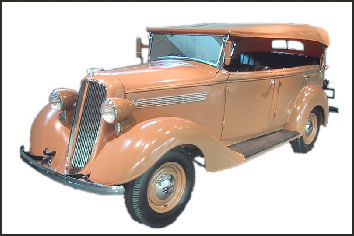
early Nissan car The Nissan conglomerate, which includes Nissan motors, was founded by Yoshisuke Aikawa (1880-1967) in Yokohama in 1933.. Its first cars were produced in 1932. Using efficient production methods, it became Japan's first mass producer of automobiles.
During World War II, Nissan stopped making cars and poured its resources into the war effort. After the war the company set a goal of producing cheap, reliable cars. By the 1950s it was a major player in the Japanese market. In 1972, it had a 32 percent share of the Japanese market, just 2 points below Toyota.
Nissan shipped its first car to the United States in 1958. It did much better than Toyota. Sales of its stylish cars increased through the 1960s and it surpassed Volkswagen as the leading U.S. import. Nissan was known as Datsun during its early years in the United States. The company grew enormously in the early 1970s with the introduction fuel efficient sedans during the Energy Crisis and hip advertisements commissioned by Peter Max and Salvador Dali with the slogan: "Own a Datsun Original." According to Kyodo News, "Datsun was a big seller especially in the United States where its sporty, two-door hatchbacks became synonymous with fuel-efficiency during the 1970s oil crisis. For many teenagers in the 1970s a Datsun was their first set of wheels."
Nissan also made a big splash with the 240Z, a flashy, powerful sports car that sold for only $3,526 when it was introduced in 1970. Costing about a third of European competitors, it was the fastest-selling sports car of all time. Millions were sold as it grew into the 260Z, 280Z, 300Z and 300ZX.
In 1981, the Datsun name was changed to Nissan as the company pushed its own name onto its fleet of cars. The move confused consumers and angered dealers, who were given little warning of the change and were required to buy new signs themselves. The move cost Nissan millions of dollars in sales.
Nissan reached its peak in 1985. The sale of its cars in the United States reached 830,000, more than Toyota and Honda, and the company's goal was to surpass Toyota as Japan’s No 1 car company.
Nissan's Decline
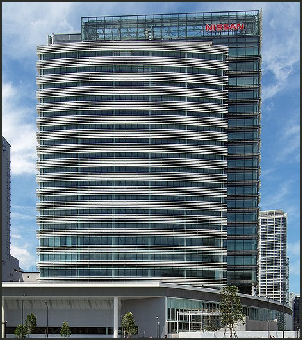
Nissan headquarters Nissan hit hard times in the 1990s. It posted losses seven years in a row beginning in 1993. The company in that period was known for it unimaginative marketing, unresponsive management, overstaffing, disputes between management and unions, and boring cars that were out of step with current trends.
Between 1985 and 1999, Nissan sales shrunk by 25 percent in the United States and it fell to a distant third behind Toyota and Honda in Japan. In fiscal year 1998-1999, Nissan lost $5.6 billion. By that time Nissan was $22 billion in debt, and may have owed its “keiretsu” partners an additional $20 billion.
Renault Takes Over Nissan
Nissan formed an alliance with French carmaker Renault in 1999. In March 1999, Renault SA purchased 37 percent of Nissan's stock for $5.5 billion and effectively took over Nissan. Immediately a downsizing plan was introduced that aimed at cutting $13 billion off of Nissan’s debt. DailmlerChysler had originally wanted to take over Nissan but changed its mind after a taking closer look at Nissan’s finances.
The move gave Renault a much needed beachhead in Asia and access to Nissan's advanced technology. The union of Renault and Nissan is still regarded as partnership not a takeover by Renault.
Today Renault owns 44 percent of Nissan and Nissan owns15 percent of Renault. Together they sold 6.13 million vehicles in 2005.
Carlos Ghosn
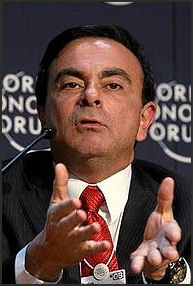
Carlos Ghosn, a Brazilian-born Lebanese Frenchman, became the head of Nissan after the Renault takeover in 1999. Known as the "Icebreaker" and "Le Cost Killer," for his ability to do what ever is necessary to make money, he is largely credited with turning Nissan around. He is very visiblein Japan, appearing regularly on television and making news in his own right, A manga that serialized his life is called “ Big Comic Superior” .
Ghosn (rhymes with phone) was born in Brazil in 1954, reared in Lebanon and went to school in Paris. He earned engineering degrees at universities in France and worked 18 years at Michelin, where he became chief of their operations in North America. He became an executive at Renault in 1996 and was made CEO of Nissan in 1999 and CEO and president of Nissan in 2000 and CEO of both Renault and Nissan in 2005. There was also some speculation that Ghosn might be given the CEO position at GM. Ghosn said he wasn’t interested. He was asked twice by Ford to be its top executive but he declined the offer both times.
Ghosn was 44 when he took the job and quickly earned a reputation as an energetic and charismatic leader, good at inspiring and mobilizing people. Ghosn describes himself as a control freak and is sometimes called 7-11 for his 7:00am to 11:00pm work schedule. He told Newsweek that he sees himself a someone "who has to be totally involved in what he is doing, who strongly believes in what he is doing, and who wants things to be done quickly." In the mid 2000s he began stopping his workday at 9:00am, he said, to give himself more energy for the future.
Ghosn attributes much of his success to a Jesuit priest at his school who taught him to listen before speaking and understand where people were coming from before making conclusions and decisions. He first made a name for himself in the business world when he restored Michelin to profitability in its key market in Brazil and organized the merger of Michelin and Uniroyal Goodrich. After arriving at Renault he played an instrumental role in returning that company to profitability in Europe.
Ghosn wears suits specially designed for him by Louis Vuitton and has a personal makeup artist who applies lip gloss among other things before he give a major speech or presentation. His schedule is broken down into 10 minute increments. When goes to the U.S. he is carried around in an Infiniti SUV
Book: “Turnabout: How Carlos Ghosn Rescued Nissan” by David Magee (Harper Business, 2003).
Ghosn Turns Nissan Around

2009 Cube Ghosn quickly turned Nissan around and guided it to the No. 2 caraker spot in Japan ahead of Honda. Debt burden was slashed; cars were made cost competitive; management was streamlined; finances were reorganized; and non-performing assets were sold off. Cost-cutting moves that should been made years ago were made. Some 21,000 jobs were cut, five domestic plants were closed and prized assets such as Nissan aerospace were auctioned off to raise money and reduce the debt. Employees were rewarded on merit not seniority and invited to join stock-option plans.
Perhaps the greatest contribution Ghosn made was shaking up relations between Nissan and its suppliers, saving tens of billions of dollars. His quest of quality materials at the cheapest price resulted in a consolidation of the steel industry. He also credited with making tough cuts without losing a day of work to strikes and keeping moral in the company high.
Ghosn vowed to quit if Nissan wasn't profitable in two years. It was profitable in one year. By offering sporty vehicles like Xterra SUV, Nissan sales jumped by 11 percent in the United States in 2000. Infiniti had its best year ever the same year. In March 2001, the company posted a record profit of $2.3 billion in the fiscal year ending in March 2001. Its debt was educed by $3 billion and its stock rose 38 percent.
In fiscal 2002-2003, Nissan posted record sales and profits again and cleared away it interest-bearing debts. Global sales were 2.77 million units. Nissan made a profit of ¥737 billion on some of the highest profit margins (10.8 percent) in the industry.
Nisan President Carlos Ghosn received ¥890 million pay package in fiscal 2009-2010. Five other company executives received more than ¥100 million. Ghosn said the pay was determined by the company’s business performance, taking into consideration how compensation of executives at other global companies receive. Ghosn received ¥982 million pay package in fiscal 2010-11, making him the highest paid executive in Japan among companies that disclosed their executive salaries. As high as Ghosn’s salary is it is lower than the global average for automobile companies, which is $15.3 million, according to Towers Watson & Co.
According to the Detroit-based Automotive News the Obama Administration asked Ghosn to be the CEA of General Motors and the Frenchman declined because his focus was on rebuilding Nissan and Renault, which were at the time suffering from serious sales declines related to the global economic crisis. In his book “Overhaul: An Insiders Account of the Obama Administration’s Emergency rescue of the Auto Industry”, White House aide Steven Rater wrote Ghosn refused because he “felt considerable loyalty to both companies [Nissan and Renault] and wanted to see them through the crisis.”
In December 2010, Nissan and Mitsubishi Motors (MMC) agreed to for an alliance to make minicars and small trucks. In January 2011, Nissan said it would market Mazda-built Premacy minivans under its brand name.
Ghosn s Japan's Top-Paid CEO in 2012
In June 2012, Ghosn revealed at a shareholder’s meeting that he was paid a salary and bonus of 987 million yen ($12.5 million) for the fiscal year 2011-2012, making him Japan's highest-paid executive.Yoko Kubota of Reuters wrote: “Although Ghosn's 0.5 percent pay rise for the past year put him just short of becoming the first CEO of a Japanese company to be paid more than 1 billion yen, investors have been far more concerned with his tenure than the terms of his compensation. [Source: Yoko Kubota, Reuters, June 25, 2012]
“Nissan has justified the higher pay for Ghosn and other Nissan executives by saying they should be compared to compensation packages for CEOs at other big, global industrial companies including Ford Motor Co and Volkswagen AG rather than the lower pay for Japanese CEOs who tend to have come up through the ranks over a career. "Recruiting and retaining these best and brightest is a competitive advantage that we cannot afford to lose," Ghosn told an annual shareholders' meeting in Yokohama. The disclosed compensation for Ghosn did not include stock options he was granted in the Japanese automaker and does not include his compensation as head of Nissan's alliance partner, Renault SA.
“Nissan said its board had weighed cash compensation for Ghosn against pay for CEOs at other major industrial companies with global operations based on advice from consulting firm Towers Watson. Nissan said the average CEO pay at the industrial companies it had used as a benchmark was $16.1 million, while the average CEO pay for global automakers was $17.5 million. That average included the $29 million paid to Ford CEO Alan Mulally and the $23 million paid to VW's Martin Winterkorn. Ghosn made another 1.2 million euros ($1.7 million) for heading Renault in 2010. A comparable number for 2011 was not immediately available.
“Ghosn's pay at Nissan has topped that of his counterparts at Toyota and Honda by a wide margin. Toyota President Akio Toyoda received 136 million yen ($1.71 million) for the past fiscal year, unchanged from a year earlier. In another point of comparison, Ghosn's pay topped the total compensation for the 21 most senior executives at Sony Corp, another Japanese company that had been headed by a foreign CEO. Ghosn, 58, told Reuters that he was not planning to step down from his post anytime soon, following a Bloomberg report that he would retire before the automaker's next business plan starts in about five years.
Nissan’s Foreign Executives
Nissan said in August 2011 that it plans to fill the majority of its top-ranking posts with non-Japanese by the end of fiscal 2016. Non-Japanese officials, such as directors and presidents of overseas units, currently account for 44 people of Nissan's 100 executives. The automaker intends to hire talented local people at its overseas units to accelerate its global advancement strategy, sources said. Currently, four out of nine Nissan directors at its headquarters are not Japanese, and nearly three-quarters of executive positions at its overseas subsidiaries have been filled with non-Japanese. [Source: Yomiuri Shimbun, August 18, 2011]
At Nissan, it is mandatory that English is spoken at meetings if at least one non-Japanese person is in attendance. The nation's second-largest automaker has also introduced a personnel management system in which employees are promoted and paid based on ability and performance, regardless of nationality.
Nissan Declines and Rebounds
Sales began to slip in the mid 2000s as Nissan failed to introduce a steady stream of new models. Some have accused Ghosn of spreading himself a little too thin between Nissan and Renault and being better suited for improving struggling companies than guided sound ones. Others criticized Nissan’s failure to keep up with Honda and Toyota on fuel-saving and hybrid technology and following Detroit’s lead and relying too-heavily on gas guzzling pick up trucks and SUVs.
There were also worries about low quality standards which among other things led to recall of Altimas in the United States because they burn oil too quickly and risk catching on fire. In December 2007, Nissan announced a recall of 686,500 Altima and Sentra cars to fix problems with a sensor that could cause the cars to stall.

2009 Maxima
In 2004, sales dropped by 4.9 percent to 743,0461 vehicles in Japan. In fiscal 2006-2007 Nissan suffered its first fall in profits since Ghosn became head of the company. Sales in 2007 fell 5.3 percent and profit was $3.9 billion, short of the $4.4 billion goal. Share prices fell 37 percent in 2007 and the first sixth months of 2008. Ghosn blamed Nissan’s problem on fuel cost that were hurting the automobile industry as a whole. He acknowledged that markets were shrinking in the United States, Japan and Europe but strong growth ahead in China, Russia, India and Brazil.
Some called for Ghosn’s resignation. In response Ghosn declared a “performance crisis” and went on cost-cutting rampage and put heavy pressure on his designers ro come up with new, exciting models. In 2007, Nissan sales surged 13 percent to ¥2.63 trillion and Nissan made a $4.8 billion profit in fiscal 2007-2008.
Nissan and the Economic Crisis in 2008 and 2009
Nissan posted $2.3 billion loss in fiscal 2008-2009, during the global financial crisis. Annual sales fell 9.5 percent to 3.41 million vehicles
Nissan responded to the crisis by cutting its worldwide workforce from 235,00 to 215,000 in fiscal 2009 and imposed 10 percent salary cuts on all board members and corporate officers. By March 2009 sales were beginning pick up significantly. Nissan increased its production by 85 percent.
Nissan received a $1.6 billion green car loan in the United States to retool its plant in Smyrna Tennessee to build electric vehicles and construct a battery manufacturing plant.
Nissan returned to the black in fiscal 2009-2010 with a profit of ¥42.39 billion for the year compared to a loss of ¥233.71 a year earlier. Nissan posted a profit of ¥106.65 billion for the April-to-June 2010 quarter, It had a loss of ¥16.53 billion in the same quarter in 2009.
Production in terms of domestic output fell by 53 percent in March 2011, when the earthquake and tsunami occurred. After the earthquake and tsunami in 2011 Nissan reached pre-disaster levels of production in October 2011.

new Z
Toyota, Nissan Pursuing Different Post-Tsunami Business Paths
August 2011, Kyodo reported: “As Japanese automakers recover from the devastation caused by the March earthquake and tsunami, two major players — Nissan and Toyota — have adopted starkly contrasting post-disaster business strategies. Nissan aims to expand in emerging markets, while Toyota (TM) will focus on enhancing customer satisfaction with its products and services rather than setting any sales targets. [Source: Kyodo, August 17, 2011]
In its medium-term management plan unveiled in June, Nissan targeted boosting its global market share to 8 percent by March 2017, which would translate into sales of a little over 7 million vehicles. If this goal is to be achieved, the company must ratchet up production by 500,000 units a year. Unveiling the ambitious plan, President Carlos Ghosn said there are considerable hurdles ahead that need to be surmounted in order to meet the target.
If the company's efforts prove successful, the combined output of Nissan and parent firm Renault SA could reach the 10 million level, giving the alliance top spot in the world's automotive industry.
In China, Nissan aims to double the annual production of its local joint venture to 2.3 million units by 2015. Nissan will also make major investments to enhance its presence in the Russian and Brazilian markets where demand is rising. Domestically, the company will focus on building more minivehicles, an area of strong demand. Instead of taking the risk of going it alone, it has decided to ally with Mitsubishi Motors Corp., which leads in this market segment.
Nissan Productivity
Nissan and Renault’s 2010 production capacity: 10.346 million vehicles. Nissan has one of the shortest production cycles and its workers are among the most productive in the automotive industry. Nissan needs 2.52 worker to make a vehicle a day at its factories in the United States compared to 2.46 Honda, 2.73 for Toyota, 2.97 for Ford, 3.04 for General Motors and 3.20 for Daimler-Chrysler.
In 2005, Nissan was named North America’s 2nd most efficient manufacturing operation after Toyota by the closely-watched Harbour Report. In that survey it took the company just 29.43 hours to produce an average car or truck. By contrast GM, Ford and Chrysler take between 34 and 37 hours to make a vehicle.
Nissan’s factory in Sunderland, England is regarded as the most efficient in Europe. About 98 vehicles are made there per employee each year.
Advances by Nissan
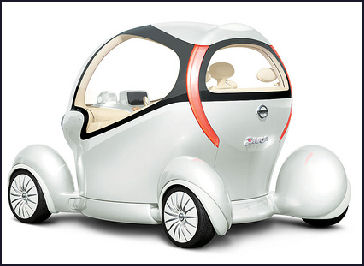
concept vehicle Nissan has developed a safety system that automatically keeps vehicles a safe distance from other vehicles at low speeds. The system uses a radar sensor to determine the relative speeds of vehicles and the relative distance from them. The technology plans to introduced in Nissan cars in 2008 or 2009.
Nissan has developed a system with cameras and graphics that make parking a breeze. When parking drivers simply try to stay within the lines shown on a screen on the dashboard. Sensors detect obstacles and send off alarms if come too close to the car. The feature initially sold for $5,000.
Nissan executives earn more money than executives at Toyota. A quarter of the executives are non-Japanese. Nissan has made a concerted an effort to hire women
Nissan Recalls
In February 2010, Nissan recalled 604,500 cars in North American due to problems in their power steering and batteries. The same month Nissan recalled 270,000 cars in North American due to problems with their steering control. Models affected include Pathfinder SUVs and Infiniti QX4 vehicles.
In May 2010, Nissan recalled 134,000 cars sold under the luxury brand Infiniti to repair an airbag flaw. In July 2010, Nissan recalled 51,100 Cube hatchbacks in the United States and Canada because of possible problems with fuel spilling during rear end collisions.
In October 2010, Nissan recalled 2.14 million cars worldwide, including popular March and Mycra models, due to ignition problems. It was the third largest recall ever. No accidents had been reported by the problem but in extreme cases it could cause the car stall and not be able to start.
Nissan is developing an electric car in China
Image Sources: Nissan and Wikipedia
Text Sources: New York Times, Washington Post, Los Angeles Times, Daily Yomiuri, Times of London, Japan National Tourist Organization (JNTO), National Geographic, The New Yorker, Time, Newsweek, Reuters, AP, Lonely Planet Guides, Compton’s Encyclopedia and various books and other publications.
Last updated October 2012
